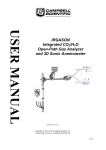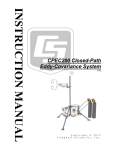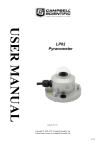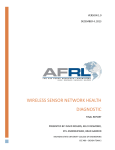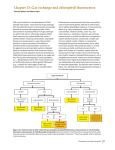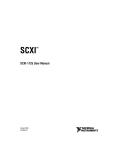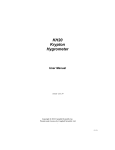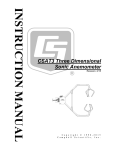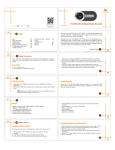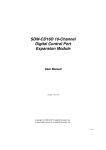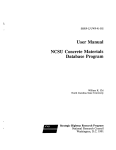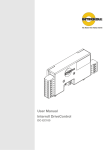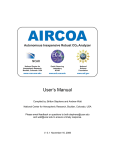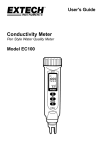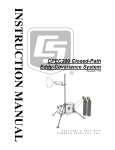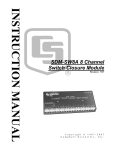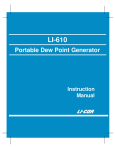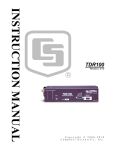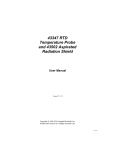Download EC155 CO2 and H2O Closed-Path Gas Analyser
Transcript
USER MANUAL EC155 CO2 and H2O Closed-Path Gas Analyser Issued: 16.11.15 Copyright © 2010-2015 Campbell Scientific, Inc. Printed under licence by Campbell Scientific Ltd. CSL 905 Guarantee This equipment is guaranteed against defects in materials and workmanship. We will repair or replace products which prove to be defective during the guarantee period as detailed on your invoice, provided they are returned to us prepaid. The guarantee will not apply to: Equipment which has been modified or altered in any way without the written permission of Campbell Scientific Batteries Any product which has been subjected to misuse, neglect, acts of God or damage in transit. Campbell Scientific will return guaranteed equipment by surface carrier prepaid. Campbell Scientific will not reimburse the claimant for costs incurred in removing and/or reinstalling equipment. This guarantee and the Company’s obligation thereunder is in lieu of all other guarantees, expressed or implied, including those of suitability and fitness for a particular purpose. Campbell Scientific is not liable for consequential damage. Please inform us before returning equipment and obtain a Repair Reference Number whether the repair is under guarantee or not. Please state the faults as clearly as possible, and if the product is out of the guarantee period it should be accompanied by a purchase order. Quotations for repairs can be given on request. It is the policy of Campbell Scientific to protect the health of its employees and provide a safe working environment, in support of this policy a “Declaration of Hazardous Material and Decontamination” form will be issued for completion. When returning equipment, the Repair Reference Number must be clearly marked on the outside of the package. Complete the “Declaration of Hazardous Material and Decontamination” form and ensure a completed copy is returned with your goods. Please note your Repair may not be processed if you do not include a copy of this form and Campbell Scientific Ltd reserves the right to return goods at the customers’ expense. Note that goods sent air freight are subject to Customs clearance fees which Campbell Scientific will charge to customers. In many cases, these charges are greater than the cost of the repair. Campbell Scientific Ltd, 80 Hathern Road, Shepshed, Loughborough, LE12 9GX, UK Tel: +44 (0) 1509 601141 Fax: +44 (0) 1509 601091 Email: [email protected] www.campbellsci.co.uk Precautions DANGER — MANY HAZARDS ARE ASSOCIATED WITH INSTALLING, USING, MAINTAINING, AND WORKING ON OR AROUND TRIPODS, TOWERS, AND ANY ATTACHMENTS TO TRIPODS AND TOWERS SUCH AS SENSORS, CROSSARMS, ENCLOSURES, ANTENNAS, ETC. FAILURE TO PROPERLY AND COMPLETELY ASSEMBLE, INSTALL, OPERATE, USE, AND MAINTAIN TRIPODS, TOWERS, AND ATTACHMENTS, AND FAILURE TO HEED WARNINGS, INCREASES THE RISK OF DEATH, ACCIDENT, SERIOUS INJURY, PROPERTY DAMAGE, AND PRODUCT FAILURE. TAKE ALL REASONABLE PRECAUTIONS TO AVOID THESE HAZARDS. CHECK WITH YOUR ORGANIZATION'S SAFETY COORDINATOR (OR POLICY) FOR PROCEDURES AND REQUIRED PROTECTIVE EQUIPMENT PRIOR TO PERFORMING ANY WORK. Use tripods, towers, and attachments to tripods and towers only for purposes for which they are designed. Do not exceed design limits. Be familiar and comply with all instructions provided in product manuals. Manuals are available at www.campbellsci.eu or by telephoning +44(0) 1509 828 888 (UK). You are responsible for conformance with governing codes and regulations, including safety regulations, and the integrity and location of structures or land to which towers, tripods, and any attachments are attached. Installation sites should be evaluated and approved by a qualified engineer. If questions or concerns arise regarding installation, use, or maintenance of tripods, towers, attachments, or electrical connections, consult with a licensed and qualified engineer or electrician. General • Prior to performing site or installation work, obtain required approvals and permits. Comply with all governing structure-height regulations, such as those of the FAA in the USA. • Use only qualified personnel for installation, use, and maintenance of tripods and towers, and any attachments to tripods and towers. The use of licensed and qualified contractors is highly recommended. • Read all applicable instructions carefully and understand procedures thoroughly before beginning work. • Wear a hardhat and eye protection, and take other appropriate safety precautions while working on or around tripods and towers. • Do not climb tripods or towers at any time, and prohibit climbing by other persons. Take reasonable precautions to secure tripod and tower sites from trespassers. • Use only manufacturer recommended parts, materials, and tools. Utility and Electrical • You can be killed or sustain serious bodily injury if the tripod, tower, or attachments you are installing, constructing, using, or maintaining, or a tool, stake, or anchor, come in contact with overhead or underground utility lines. • Maintain a distance of at least one-and-one-half times structure height, or 20 feet, or the distance required by applicable law, whichever is greater, between overhead utility lines and the structure (tripod, tower, attachments, or tools). • Prior to performing site or installation work, inform all utility companies and have all underground utilities marked. • Comply with all electrical codes. Electrical equipment and related grounding devices should be installed by a licensed and qualified electrician. Elevated Work and Weather • Exercise extreme caution when performing elevated work. • Use appropriate equipment and safety practices. • During installation and maintenance, keep tower and tripod sites clear of un-trained or non-essential personnel. Take precautions to prevent elevated tools and objects from dropping. • Do not perform any work in inclement weather, including wind, rain, snow, lightning, etc. Maintenance • Periodically (at least yearly) check for wear and damage, including corrosion, stress cracks, frayed cables, loose cable clamps, cable tightness, etc. and take necessary corrective actions. • Periodically (at least yearly) check electrical ground connections. WHILE EVERY ATTEMPT IS MADE TO EMBODY THE HIGHEST DEGREE OF SAFETY IN ALL CAMPBELL SCIENTIFIC PRODUCTS, THE CUSTOMER ASSUMES ALL RISK FROM ANY INJURY RESULTING FROM IMPROPER INSTALLATION, USE, OR MAINTENANCE OF TRIPODS, TOWERS, OR ATTACHMENTS TO TRIPODS AND TOWERS SUCH AS SENSORS, CROSSARMS, ENCLOSURES, ANTENNAS, ETC. PLEASE READ FIRST About this manual Please note that this manual was originally produced by Campbell Scientific Inc. primarily for the North American market. Some spellings, weights and measures may reflect this origin. Some useful conversion factors: Area: 1 in2 (square inch) = 645 mm2 Length: 1 in. (inch) = 25.4 mm 1 ft (foot) = 304.8 mm 1 yard = 0.914 m 1 mile = 1.609 km Mass: 1 oz. (ounce) = 28.35 g 1 lb (pound weight) = 0.454 kg Pressure: 1 psi (lb/in2) = 68.95 mb Volume: 1 UK pint = 568.3 ml 1 UK gallon = 4.546 litres 1 US gallon = 3.785 litres In addition, while most of the information in the manual is correct for all countries, certain information is specific to the North American market and so may not be applicable to European users. Differences include the U.S standard external power supply details where some information (for example the AC transformer input voltage) will not be applicable for British/European use. Please note, however, that when a power supply adapter is ordered it will be suitable for use in your country. Reference to some radio transmitters, digital cell phones and aerials may also not be applicable according to your locality. Some brackets, shields and enclosure options, including wiring, are not sold as standard items in the European market; in some cases alternatives are offered. Details of the alternatives will be covered in separate manuals. Part numbers prefixed with a “#” symbol are special order parts for use with non-EU variants or for special installations. Please quote the full part number with the # when ordering. Recycling information At the end of this product’s life it should not be put in commercial or domestic refuse but sent for recycling. Any batteries contained within the product or used during the products life should be removed from the product and also be sent to an appropriate recycling facility. Campbell Scientific Ltd can advise on the recycling of the equipment and in some cases arrange collection and the correct disposal of it, although charges may apply for some items or territories. For further advice or support, please contact Campbell Scientific Ltd, or your local agent. Campbell Scientific Ltd, Campbell Park, 80 Hathern Road, Shepshed, Loughborough, LE12 9GX, UK Tel: +44 (0) 1509 601141 Fax: +44 (0) 1509 601091 Email: [email protected] www.campbellsci.co.uk Contents PDF viewers note: These page numbers refer to the printed version of this document. Use the Adobe Acrobat® bookmarks tab for links to specific sections. 1. Introduction ................................................................. 1 2. Cautionary Statements ............................................... 1 3. Initial Inspection ......................................................... 2 4. Overview...................................................................... 2 5. Specifications ............................................................. 3 5.1 5.2 5.3 5.4 Measurements........................................................................................... 3 Output Signals .......................................................................................... 5 Physical Description ................................................................................. 6 Power Requirements ................................................................................. 8 6. Installation................................................................... 8 6.1 Mounting .................................................................................................. 8 6.2 Plumbing ................................................................................................ 11 6.2.1 Flow .............................................................................................. 11 6.2.2 Pressure ........................................................................................ 11 6.2.3 Filtration ....................................................................................... 12 6.2.4 Plumbing Connections .................................................................. 12 6.2.4.1 Sample Intake ..................................................................... 10 6.2.4.2 Pump ................................................................................... 10 6.2.4.3 Zero/Span ............................................................................ 10 6.3 Wiring and Connections ......................................................................... 13 7. Settings ..................................................................... 16 7.1 Factory Defaults ..................................................................................... 16 7.2 Details .................................................................................................... 17 7.2.1 SDM Address ............................................................................... 17 7.2.2 Bandwidth..................................................................................... 17 7.2.3 Unprompted Output ...................................................................... 17 7.2.4 Unprompted Output Rate .............................................................. 17 7.2.5 RS485 Baud Rate ......................................................................... 17 7.2.6 Analogue Output........................................................................... 17 7.2.7 ECMon Update Rate..................................................................... 18 7.2.8 Temperature Sensor ...................................................................... 18 7.2.9 Fixed Temperature Value ............................................................. 18 7.2.10 Pressure Sensor ........................................................................... 18 7.2.10.1 Pressure Gain .................................................................... 18 7.2.10.2 Pressure Offset .................................................................. 18 7.2.10.3 Fixed Pressure Value ........................................................ 19 7.2.11 Differential Pressure ................................................................... 19 i 7.3 ECMon ................................................................................................... 19 7.4 Device Configuration Utility .................................................................. 21 8. EC100 Outputs .......................................................... 21 8.1 SDM Output ........................................................................................... 22 8.2 USB or RS-485 Output ........................................................................... 22 8.3 Analogue Outputs ................................................................................... 24 9. Maintenance .............................................................. 24 9.1 9.2 9.3 9.4 9.5 9.6 Routine Maintenance .............................................................................. 24 Intake Filter Replacement ....................................................................... 25 Cleaning Analyzer Windows .................................................................. 25 Zero and Span ......................................................................................... 28 Replacing the EC155 Desiccant/CO2 Scrubber Bottles .......................... 32 Factory Recalibration ............................................................................. 33 10. Datalogger Programming with CRBasic ............... 33 10.1 EC100() Instruction .............................................................................. 34 10.2 EC100Configure() Instruction .............................................................. 37 10.3 Example CRBasic Program .................................................................. 40 11. Theory of Operation ................................................ 41 Appendices A. Filter Bandwidth and Time Delay .......................... A-1 B. Useful Equations .................................................... B-1 C. MSDS (Material Safety Data Sheet) Forms ........... C-1 C.1 Magnesium Perchlorate MSDS ............................................................ C-1 C.2 Decarbite MSDS .................................................................................. C-2 D. EC155 Sample Cell and Intake Maintenance ........ D-1 D.1 Cleaning Sample Cell .......................................................................... D-1 D.2 Cleaning Intake Tube ........................................................................... D-1 Figures 5-1. Dimensions of EC155 Analyzer Head with Optional Heated Intake ....... 7 5-2. Dimensions of EC155 Analyzer Head without Optional Heated Intake .. 7 6-1. Exploded view of mounting the EC155 Gas Analyzer and the CSAT3A Sonic Head ........................................................................... 9 6-2. EC100 Enclosure Mounting Bracket mounted on a vertical mast (left) and a tripod leg (right) ....................................................................... 10 6-3. Exploded view of mounting the EC100 Enclosure ................................ 11 6-4. End views of the analyzer showing the sample intake (optional heated intake not shown), pump outlet, and zero/span intake ............ 12 ii 6-5. EC100 Electronics Front Panel. The picture on the left shows the panel as it is shipped from the factory (enhanced barometer shown). The picture on the right shows the panel after the user has done all the wiring and made all connections (basic barometer used) ............. 13 6-6. Bottom of EC100 Enclosure ................................................................. 14 7-1. The Main Window of ECMon .............................................................. 20 7-2. The Setup Window in ECMon .............................................................. 20 7-3. The ECMon Status Window ................................................................. 20 8-1. An example of USB data output in terminal mode ................................ 23 9-1. The underside of the optional heated intake .......................................... 25 9-2. The EC155 Analyzer with the top shell open ........................................ 26 9-3. By loosening the thumbscrews above the sample cell, the latches may be spun from position A to position B, thus freeing the struts of the analyzer.................................................................................... 27 9-4. The EC155 Analyzer and Sample Cell with shell top open .................. 27 9-5. Analyzer removed from sample cell and shell ...................................... 28 9-6. ECMon Display Window showing real-time CO2 and H2O .................. 29 9-7. ECMon Zero/Span Window .................................................................. 31 9-8. Replacing the source housing desiccant/scrubber bottle ....................... 33 9-9. Replacing the detector housing desiccant/scrubber bottle ..................... 33 A-1. Frequency Response of the EC100 Filter at various bandwidths ....... A-2 A-2. Frequency response comparison of the EC100 10-Hz bandwidth and a 50-msec moving average ........................................................ A-3 Tables 6-1. EC100 SDM output to a Campbell Scientific CR1000, CR3000, or CR5000 Datalogger ........................................................................... 15 7-1. Factory Default Settings ........................................................................ 16 8-1. USB and RS-485 Output Elements ....................................................... 23 8-2. Multipliers and Offsets for Analogue Outputs ...................................... 24 10-1. Output Modes for EC100 Instruction .................................................. 34 10-2. Bits in the Sonic Diagnostic Flag ........................................................ 35 10-3. Bits in the Gas Diagnostic Flag ........................................................... 36 10-4. ConfigCmd Values for Setting and Retrieving Settings ...................... 38 A-1. Filter Time Delays for Various Bandwidths ....................................... A-3 iii iv EC155 Packing Information The EC155 components are placed in a foam cutout that helps protect them from damage during shipment. The EC155 should look like one of the photographs below, depending on the sample cell option ordered. After unpacking, it is recommended to save the foam cutout as the EC155 components should be placed in the foam cutout whenever the EC155 is transported to another location. Note: Another box containing the Sonic Head and its components will also be shipped with the EC155 analyzer if Sensing Head Option –SH has been ordered. EC100 Electronics with Enclosure Extra Pocket for End User Added Parts #25995 EC100 Enclosure Mounting #27007 CD-ROM Certificate of Conformance Gas Sensor Head Cable Sample Cell Cable #26563 USB Cable Sample Cell with Intake and Gas Sensor Head (if ordered –SI) #26559 Boom Adapter #26570 EC155 Mounting Platform Figure 1. EC155 with Sample Cell Option -SI EC100 Electronics with Enclosure Extra Pocket for End User Added Parts Sample Cell with Gas Sensor Head (if ordered –SN) Gas Sensor Head Cable Sample Cell Cable #26563 USB Cable #26559 Boom Adapter #25995 EC100 Enclosure Mounting #27007 CD-ROM Certificate of Conformance #26570 EC155 Mounting Platform Figure 2. EC155 with Sample Cell Option -SN Campbell Scientific, Inc. USA | AUSTRALIA | | BRAZIL 815 W 1800 N | CANADA | | Logan, Utah 84321-1784 COSTA RICA | ENGLAND | | (435) 753-2342 FRANCE | GERMANY www.campbellsci.com | | SOUTH AFRICA | SPAIN Printed 6/1/2011 EC155 CO2 and H2O Closed-Path Gas Analyzer and EC100 Electronics with Optional CSAT3A 3D Sonic Anemometer 1. Introduction The EC155 is an in-situ, closed-path, mid-infrared absorption gas analyzer that measures molar mixing ratios of carbon dioxide and water vapour, along with sample cell temperature and pressure. The EC155 may be used in conjunction with the CSAT3 sonic anemometer, which measures orthogonal wind components. Before using the EC155, please study Section 2, Cautionary Statements Section 3, Initial Inspection Section 6, Installation More details are available in the remaining sections. 2. Cautionary Statements DANGER: o The scrubber bottles (see Section 9.5, Replacing the EC155 Desiccant/CO2 Scrubber Bottles) contain the strong oxidizing agents sodium hydroxide (caustic soda, NaOH) and anhydrous magnesium perchlorate (Mg(ClO4)2). Avoid direct contact with the chemicals. Ensure your work area is well ventilated and free of reactive compounds, including liquid water. Store used chemical bottles in a sealed container until disposal. Dispose of chemicals and bottles properly. Materials Safety Data Sheets (MSDS) are provided in Appendix C. MSDS are updated periodically by chemical manufacturers. Obtain current MSDS at www.campbellsci.com. WARNING: o Do not carry the EC155 or CSAT3A by the arms or carry the EC155 by the strut between the arms. Always hold them by the block, where the upper and lower arms connect. o Handle the EC155 carefully. The optical source may be damaged by rough handling, especially while the analyzer is powered. o Over-tightening bolts will damage or deform the mounting hardware. 1 EC155 CO2 and H2O Closed-Path Gas Analyzer and EC100 Electronics with Optional CSAT3A 3D Sonic Anemometer CAUTION: o Grounding the EC100 measurement electronics is critical. Proper grounding to earth (chassis) will ensure maximum ESD (electrostatic discharge) protection and improve measurement accuracy. o Do not connect or disconnect the gas analyzer or sonic connectors while the EC100 is powered. o The SDM, USB, and RS-485 output options include EC155 diagnostic data. Be aware that the absence of diagnostic data in the analogue output option could make troubleshooting difficult and may lead to the user not being aware of potential problems with the instrumentation (see Section 8, EC100 Outputs). o Resting the analyzer on its side during the zero-and-span procedure may result in measurement inaccuracy. o When cleaning the gas-analyzer window, make sure the alcohol and any residual water completely evaporate before proceeding with the zero-and-span procedure (see Section 9.3, Cleaning Analyzer Windows). 3. Initial Inspection Upon receipt of your equipment, inspect the packaging and contents for damage. File damage claims with the shipping company. 4. Overview The EC155 is a closed-path, mid-infrared absorption analyzer that measures molar mixing ratios of carbon dioxide and water vapour, along with sample cell temperature and pressure. It has been designed specifically for eddy covariance flux measurements and may be used in conjunction with the CSAT3A 3D sonic anemometer head. The analyzer has a rugged, aerodynamic design with low power requirements, making it suitable for field applications. The EC155 gas analyzer connects directly to the EC100 electronics, which computes real-time CO2 and H2O molar mixing ratios of the air inside the sample cell of the analyzer. A CSAT3A sonic anemometer head may also be connected to the EC100. The EC155 has been designed specifically to address issues of aerodynamics, power consumption, performance during precipitation events, ambient air density fluctuations, temporal synchronicity, and system integration. Its unique design enables it to operate with only 4.8 W power; it has minimal spatial displacement from the sample volume of a CSAT3A sonic anemometer; the EC100 electronics synchronize data from the EC155 and CSAT3A; and the analyzer is easily integrated into the CPEC200 closed-path eddy covariance system, a turn-key system containing data acquisition and control instrumentation, a sample pump, and optional zero-and-span valve module. 2 User Manual 5. Specifications 5.1 Measurements Features To compute carbon dioxide, water vapour, and sensible heat fluxes using the eddy-covariance method, the EC155 measures: o absolute carbon dioxide o water vapour mixing ratios o three-dimensional wind speed (requires CSAT3A) o sonic air temperature (requires CSAT3A) o sample cell temperature o barometric pressure. These measurements are required to compute carbon dioxide and water vapour fluxes using the: Standard outputs: o CO2 mixing ratio, H2O mixing ratio o gas analyzer diagnostic flags o cell temperature, cell pressure o CO2 signal strength, H2O signal strength o differential pressure o air temperature and air pressure are auxiliary sensor inputs. Additional outputs: o ux, uy, and uz orthogonal wind components o sonic temperature (based on the measurement of c, the speed of sound) o sonic diagnostic flags. Compatibility: CR1000 CR3000 CR5000 Measurement Rate: Output bandwidth2: Output rate2: 60 Hz 5, 10, 12.5, 20, or 25 Hz 5 to 50 Hz Operating temperature: -30o to 50oC Gas analyzer Measurement precision1 CO2 density: H2O density: Factory calibrated range CO2: H2O: Analyzer temp: Baro pressure: CO2 performance Zero max drift3: Gain Drift: Sensitivity to H2O: 0.2 mg·m-3 (0.15 µmol·mol-1) 0.00350 g·m-3 (0.006 mmol·mol-1) 0 to 1830 mg·m-3 (0 to 1000 ppm) 0 to 83 ppt (-60o to 37oC dew point) -30o to 50oC 70 to 106 kPa ±0.55 mg·m-3·°C-1 (±0.3 μmol·mol·°C-1) ±0.1% of reading·°C-1 (maximum) ±5.6 x 10-5 µmol CO2·mol-1 H2O (max) 3 EC155 CO2 and H2O Closed-Path Gas Analyzer and EC100 Electronics with Optional CSAT3A 3D Sonic Anemometer H2O performance Zero max drift3: Gain Drift: Sensitivity to CO2: ±0.037 g·m-3·°C-1 (±0.05 mmol·mol-1·°C-1) ±0.3% of reading·°C-1 (maximum) ±0.05 mol H2O·mol-1 CO2 (maximum) CSAT3A sonic measurement precision4 ux: 1 mm·s-1 uy: 1 mm·s-1 uz: 0.5 mm·s-1 Sonic temperature: 0.025oC CSAT3A sonic accuracy5 Offset error ux, uy: < ±8 cm·s-1 uz: < 4 cm·s-1 Gain error Wind vector ±5° horizontal: < ±2% of reading Wind vector ±10° horizontal: < ±3% of reading Wind vector ±20° horizontal: < ±6% of reading CSAT3A sonic reporting range Full scale wind: ±65.553 m/s Sonic temperature: -50° to +60°C Sample cell sensors6 Barometer Basic barometer Accuracy: -30 to 0oC ±3.7 kPa at -30oC, falling linearly to ±1.5 kPa at 0oC o o 0 C to 50 C ±1.5 kPa Measurement rate: 10 Hz Optional enhanced barometer: Manufacturer: Vaisala Model: PTB110/CS106 Accuracy: -30 to +50oC: ±0.15 kPa Measurement rate: 1Hz Temperature sensor: Manufacturer: BetaTherm Model: 100K6A1A Thermistor Accuracy: ±0.15oC (0o to 50oC) 1 2 3 4 5 6 4 noise rms, assumes: o 25°C o 85 kPa o 19 mmol/mol H2O concentration o 326 mmol/mol CO2 concentration o 25 Hz bandwidth. user selectable -30° to 50°C noise rms assumes: o -30° to +50°C o wind speed <30 m·s-1 o azimuth angles between ±170° refer to manufacturer’s product brochure or manual for details User Manual 5.2 Output Signals Features EC100 electronics outputs data using: o CS SDM o RS-485 o USB o Analogue out Digital SDM (Synchronous Device for Measurement)1 Data type: FLOAT RS-485 Data type: Output Rate: Baud rate: USB Data type: Output rate: ASCII 5 to 50 Hz (user selectable) 1200 to 230400 bps (user selectable) ASCII 5 to 50 Hz (user selectable) Analogue (two outputs for CO2 and H2O molar mixing ratios) Voltage range: 0 mV to 5000 mV Resolution: 76 µV (16 bit) Update rate: 150 Hz Accuracy (at 25oC): ±3 mV CO2 mixing ratio equation: µmol/mol = 211.27 (Vout) – 56.34 Full scale range: -56 to 1000 µmol/mol H2O mixing ratio equation: mmol/mol = 11.31 (Vout) – 3.04 Full scale range: -3 to 53 mmol/mol 1 Synchronous Device for Measurement. A Campbell Scientific, Inc. proprietary serial interface for datalogger to peripheral and sensor communication. See Section 8.1, SDM Output for details. 5 EC155 CO2 and H2O Closed-Path Gas Analyzer and EC100 Electronics with Optional CSAT3A 3D Sonic Anemometer 5.3 Physical Description Sample cell volume: 5.9 cm3 (0.36 in3) Sample cell length: 12.0 cm (4.72 in) Sample cell diameter: 7.94 mm (0.313 in) Spatial separation between EC155 optional intake and CSAT3A sample volume: 15 cm (6.0 in) Length of tubing from tip of optional heated intake to sample cell: 58.4 cm (23 in) Inside diameter of intake tubing: 2.67 mm (0.105 in) Dimensions Analyzer: Length of optional intake: EC100 electronics: Cable length: Weight Analyzer: Mounting hardware: EC100 electronics and enclosure: Connections Pump: Zero/Span: Sample Intake: 6 42.7 cm x 7.4 cm x 10.1 cm (16.8 in x 9 in x 4.0) 38.1 cm (15.0 in) 24.1 cm x 35.6 cm x 14 cm (9.5 in x 14 in x 5.5 in) 3 m (9.8 ft) from analyzer to EC100 electronics 3.9 kg (8.5 lbs) 0.4 kg (0.9 lbs) 3.2 kg (7 lbs) 3/8 inch Swagelok 1/4 inch Swagelok 1/8 inch Swagelok or Optional Heated Intake Assembly User Manual Figure 5-1. Dimensions of EC155 analyzer head with optional heated intake Figure 5-2. Dimensions of EC155 analyzer head without optional heated intake 7 EC155 CO2 and H2O Closed-Path Gas Analyzer and EC100 Electronics with Optional CSAT3A 3D Sonic Anemometer 5.4 Power Requirements Voltage supply: 10 to 16 Vdc Power at 25oC including CSAT3A: 4.8 W Power at 25oC excluding CSAT3A: 4.0 W Power at 25oC in power-down mode (CSAT3A fully powered and EC155 in stand-by): 3.0 W Power for optional heated intake: set by user, 0 to 0.7 W. 6. Installation 6.1 Mounting The EC155 is supplied with mounting hardware to attach it to the end of a horizontal pipe of 1.31 inch outer diameter, such as the CM202, CM204, or CM206 crossarm (p/n #1790x). The EC155 mounting hardware also accommodates an optional CSAT3A sonic anemometer, placing it at the proper position when the EC155 is configured with the optional heated intake assembly. The following steps describe the normal mounting procedure with the optional heated intake assembly and optional CSAT3A sonic head. Other mounting arrangements are acceptable as long as the analyzer is upright. The bottom of the analyzer has two #6-32 UNC-thread mounting holes for applications that do not use the EC155 mounting platform. Refer to Figure 6-1 throughout this section. a. WARNING 8 Mount a CM202, CM204, or CM206 crossarm (p/n #1790X) to a tripod or other vertical structure using a CM210 crossarm-to-pole bracket (p/n #17767). The crossarm should be within ± 7 degrees of horizontal to allow the CSAT3A sonic anemometer to be levelled. Do not carry the EC155 by the intake or the CSAT3A by the arms. Always hold the instruments by the body or base. b. Mount the CM250 levelling mount (p/n #26559) on the end of the crossarm. Tighten the set screws on the levelling mount. c. Bolt the mounting platform (p/n #26570) to the CM250 levelling mount (p/n #26559). d. Place the EC155 gas analyzer on the mounting platform so the four rubber feet fit into the platform holes, and tighten the captive screws located on the bottom of the platform into the mounting holes on the bottom of the analyzer. e. If a CSAT3A is being used, mount it on the end of the mounting platform using the captive CSAT3A mounting bolt. f. Level the assembly by slightly loosening the bolt in the CM250 levelling mount. Adjust the assembly until the levelling bubble on top of the CSAT3A is in the bulls eye. Retighten the bolt. User Manual WARNING Over-tightening bolts will damage or deform the mounting hardware. WARNING Use caution when handling the EC155 gas analyzer. The optical source may be damaged by rough handling, especially when the EC155 is powered. NOTE If the assembly is to be mounted on a high tower, it can be hoisted using the handle on the front of the analyzer and the holes in the mounting platform. CSAT3A Sonic Anemometer Head Mounting Platform (p/n #26570) EC155 Gas Analyzer CM20X Crossarm (p/n #1790X) CM250 Levelling Mount (p/n #26559) Figure 6-1. Exploded view of mounting the EC155 gas analyzer and the CSAT3A sonic head 9 EC155 CO2 and H2O Closed-Path Gas Analyzer and EC100 Electronics with Optional CSAT3A 3D Sonic Anemometer NOTE The CSAT3A sonic anemometer is an updated version of the CSAT3, designed to work with the EC100 electronics. An existing CSAT3 may be upgraded to a CSAT3A. Contact Campbell Scientific for details. g. Attach the EC100 electronic enclosure to the mast, tripod leg, or other part of the mounting structure. To do this, attach the EC100 enclosure mounting bracket (p/n #26604) to the pipe by loosely tightening the u-bolts around the pipe. The u-bolts are found in the mesh pocket inside the EC100 enclosure. If the pipe does not run vertically up-and-down (e.g., if you are attaching the enclosure to a leg of a tripod), rotate the bracket to the side of the pipe. As the enclosure must hang up-right, angle adjustments may need to be made by loosening the four nuts and rotating the bracket plates relative to one another. If the necessary angle cannot be reached in the given orientation, the four nuts may be removed and the top plate indexed by 90 degrees to allow the bracket to travel in the other direction (see Figure 6-2). Once adjusted, tighten all the nuts. Finally attach the EC100 enclosure to the bracket by loosening the bolts on the back of the enclosure, hanging the enclosure on the mounting bracket (it should slide into place and be able to securely hang from the bracket), and tightening the bolts (see Figure 6-3). Figure 6-2. EC100 enclosure mounting bracket mounted on a vertical mast (left) and a tripod leg (right) 10 User Manual Figure 6-3. Exploded view of mounting the EC100 enclosure h. Remove the EC100 enclosure desiccant from the plastic bag and put it back in the mesh pocket of the enclosure. Adhere the humidity indicator card to the inside of the enclosure. 6.2 Plumbing 6.2.1 Flow The EC155 has a small sample cell volume (5.9 cm3) to give good frequency response at a relatively low flow rate. The sample cell residence time is 50 ms for a nominal 7 LPM flow. The CPEC200 pump module is designed to provide this flow for the EC155, but other user-supplied pumps may be used. There is no specific limitation to the flow rate that may be used with the EC155, but the sample cell pressure must be considered. 6.2.2 Pressure The EC155 is designed to be used near ambient pressure, but it will not be damaged by operation under vacuum. The EC155 includes a differential pressure sensor to measure the sample cell pressure relative to ambient pressure, which has a range of ± 7 kPa. If the EC155 is operated less than 7 kPa from ambient pressure, the user must attach a separate, user-supplied pressure sensor. The pressure drop in the optional heated intake assembly is approximately 2.5 kPa at 7 LPM flow with no filter. The filter adds approximately 1 kPa pressure drop when it is clean. This pressure drop will increase as the filter clogs. The filter should be replaced before the differential pressure reaches -7 kPa (unless the user has supplied a pressure sensor with a wider range). See Section 9.2, Intake Filter Replacement for details on replacing the filter. 11 EC155 CO2 and H2O Closed-Path Gas Analyzer and EC100 Electronics with Optional CSAT3A 3D Sonic Anemometer If the EC155 is configured without the optional heated intake assembly, there is tubing connecting the sample inlet fitting to the sample cell that will drop the pressure approximately 4 kPa at 7 LPM. 6.2.3 Filtration The EC155 will not be damaged by use without an inlet filter, although a coarse screen (up to 1 mm hole size) is suggested to keep large debris out. Over time particulates will collect on the optical windows, reducing the signal levels until the windows must be cleaned (see Section 9.3, Cleaning Analyzer Windows). Using a filter on the inlet will increase the time before the windows must be cleaned. A finer pore size will keep the windows clean longer, but will need to be replaced more frequently. The optional heated intake assembly includes a 20 micron filter element, which gives a compromise between filter replacement and window cleaning. 6.2.4 Plumbing Connections There are three connections to the EC155 sample cell: the sample inlet, zero-andspan inlet, and pump outlet, as illustrated in Figure 6-4. In the normal mode, a vacuum pump pulls an air sample from the sample inlet through the sample cell. In zero-and-span mode the pump is turned off and a zero-and-span gas is pushed backwards through the sample cell, exhausted out through the sample inlet. Analyzer Head Cable Sample Cell Cable Figure 6-4. End views of the analyzer showing the sample intake (optional heated intake not shown), pump outlet, and zero-and-span intake 6.2.4.1 Sample Intake The EC155 can be ordered with a factory-installed intake assembly, or with a Swagelok fitting to attach a user-supplied intake assembly. If the EC155 is configured with the intake assembly, it is installed at the factory. No further assembly is required. 12 User Manual If the EC155 is configured with no intake assembly, it has a 1/8 inch Swagelok fitting at the front end for connection to the user-supplied intake assembly (see Figure 6-4). 6.2.4.2 Pump In normal mode the EC155 uses a vacuum pump to pull an air sample through the sample cell. See the discussion on flow and pressure in the previous section for pump requirements. The CPEC200 pump module (p/n #26399-x) is designed for use with the EC155. Connect the CPEC200 pump module or user-supplied sample pump to the 3/8 inch Swagelok fitting at the back end of the analyzer labelled Pump. 6.2.4.3 Zero and Span The zero-and-span inlet connects to the pump connection passage near the outlet of the sample cell. During normal operation the zero-and-span inlet should be plugged, either with a Swagelok 1/4 inch plug, or with a tube connecting to a closed valve or manifold system such as the CPEC200 valve module. During zero and span the zero or span gas can be pushed into this fitting to flow backward through the sample cell and exhausted through the intake assembly. NOTE The CPEC200 system includes a valve module controlled by a CR3000 datalogger, which automates the zero gas and CO2 span gas flows during the zero-and-span procedure. 6.3 Wiring and Connections Figure 6-5 and Figure 6-6 below show EC100 electronics panel and the bottom of the EC100 enclosure, respectively. Refer to these figures during wiring and connecting. Figure 6-5. EC100 electronics front panel. The picture on the left shows the panel as it is shipped from the factory (enhanced barometer shown). The picture on the right shows the panel after the user has done all the wiring and made all connections (basic barometer used). 13 EC155 CO2 and H2O Closed-Path Gas Analyzer and EC100 Electronics with Optional CSAT3A 3D Sonic Anemometer Figure 6-6. Bottom of EC100 enclosure CAUTION NOTE 14 Do not connect or disconnect the EC155 gas analyzer head or CSAT3 sonic head while the EC100 is powered. a. Connect the EC155 gas analyzer head. Begin by removing the black rubber cable entry plug (p/n #26224) on the bottom right of the EC100 enclosure. (This plug can be stored in the mesh pocket of the enclosure). Now insert the cable entry plug that is attached to the large cable of the EC155 gas analyzer head into the vacant slot. Push the connector at the end of the cable onto its mating connector (labelled Gas Analyzer) and tighten the thumbscrews (see Figure 6-6). The EC155 gas analyzer cable is approximately 3 metres in length. b. Connect the EC155 sample cell cable. Unscrew the sample cell connector cover, which is found on the bottom of the EC100 enclosure. Insert the 12prong sample cell cable connector into the female connector on the enclosure and screw it firmly in place. The EC155 sample cell cable is approximately 3 metres in length. c. Connect the CSAT3A sonic head (skip this step if not using the CSAT3A). Similar to (a), begin by removing the black rubber cable entry plug found on the bottom left of the EC100 enclosure. Insert the cable entry plug on the CSAT3A cable into the slot and connect the male end to the female connector labelled Sonic Anemometer on the EC100 electronics (see Figure 6-5). Tighten the thumbscrews. The CSAT3A cable is approximately 3 metres in length. Unlike previous models of the CSAT3 3D sonic anemometer, the CSAT3A sonic head and the EC155 gas analyzer head have embedded calibration information. This means that any CSAT3A and any EC155 may be used with any EC100. User Manual d. CAUTION Ground the EC100 by attaching a thick wire (e.g., 12 AWG) to the grounding lug found on the bottom of the EC100 enclosure. The other end of the wire should be connected to earth (chassis) ground (i.e., grounding rod). For more details on grounding, see the CR3000 datalogger manual, grounding section. Grounding the EC100 and other electrical components in the measurement system is critical. Proper grounding to earth (chassis) will ensure the maximum ESD (electrostatic discharge) protection and higher measurement accuracy. e. Connect a communications signal cable to the EC100. Loosen the nut on one of the cable entry seals (Cable 1 or Cable 2) on the bottom of the EC100, remove the plastic plug (the plug can be stored in the mesh pocket in the enclosure), insert the cable, and retighten the nut by hand. Refer to the sections below on SDM, USB, RS-485, and analogue communications for information on required signal cable types and connections to the EC100 panel. 1. SDM Communications: Use cable CABLE4CBL-L (p/n #21972). “L” denotes the length of the cable, which is customer-specified at time of order. Table 6-1 below details which colour of wire in the cable should be connected to each terminal found on the SDM connector of the EC100 panel. Table 6-1. EC100 SDM output to a Campbell Scientific CR1000, CR3000, or CR5000 Datalogger EC100 Channel Description Colour SDM-C1 SDM Data Green SDM-C2 SDM Clock White SDM-C3 SDM Enable Red (or brown) G Digital Ground Black G Shield Clear 2. USB Communications: Use the EC100 USB cable (p/n #26561) to connect a PC to the on the bottom of the EC100 enclosure. 3. RS-485 Communications: Use cable CABLE3TP-L (p/n #26987) for lengths less than 500 ft. The connector on the EC100 panel labelled RS485 displays which terminals are for receiving and transmitting. 4. Analogue Output: Use CABLE4CBL-L (p/n #21972) or CABLE2TP-L (#26986-L). Once again, the customer specifies the length of this cable at time of order. The connector labelled Analogue Outputs on the EC100 panel indicates where each wire should be connected (CO2 voltage signal, H2O voltage signal, and two ground connections). f. Wire power and ground (i.e., power reference) cable CABLEPCBL-L (p/n #21969-L) to the EC100. Feed the cable through one of the cable port openings in the bottom of the EC100 enclosure and attach the ends into the green EC100 power connector (p/n #3768). Plug the connector into the female power connector on the EC100 panel. Ensure that the power and ground ends are going to the appropriate terminals labelled 12V and ground, respectively. g. Connect the power cable to a power source. The power and ground ends may be wired to the 12V and G ports, respectively, of a Campbell Scientific datalogger or to another 12 Vdc source. 15 EC155 CO2 and H2O Closed-Path Gas Analyzer and EC100 Electronics with Optional CSAT3A 3D Sonic Anemometer h. Once power is applied to the EC100, three LED status lights on the EC100 panel will illuminate. The power LED will be green and the sonic and gas LEDs will be red until the unit has warmed up and is ready to make measurements at which time the LEDs will be green. If after several minutes the LED lights do not turn green, a diagnostic flag has been detected. Check the individual diagnostic bits to determine the specific fault. Diagnostics may be monitored using the Status window of ECMon, the user interface software included with the EC155 (see Section 7, Settings), or with a datalogger (see Section 10, Datalogger Programming with CRBasic). The diagnostics may reveal that the unit needs to be serviced (e.g., clean the optical windows of the sample cell, clear the CSAT3A transducers of ice or debris, etc.). 7. Settings Operation of the EC155 can be customized by changing the values of the settings. Factory defaults will work well for most applications, but the user may adjust the settings with a PC using either the ECMon software (see Section 7.3, ECMon) or the Device Configuration Utility (see Section 7.4, Device Configuration Utility), or with a datalogger using the EC100Configure() instruction (see Section 10.2, EC100Configure() Instruction). 7.1 Factory Defaults Table 7-1 shows the default value for each of the settings. Table 7-1. Factory Default Settings SDM Address Bandwidth Unprompted Output RS-485 Baud Rate Unprompted Output Rate Analogue Output ECMon Update Rate Temperature Sensor Pressure Sensor Pressure Differential Enable Heater Control 16 1 20 Hz Disabled 115200 bps 10 Hz Disabled 10 Hz Auto-Detect (EC155 Sample Cell Thermocouple) EC100 Basic or EC100 Enhanced (depending on order) Auto-Detect (Enabled for EC155) Disabled User Manual 7.2 Details This section gives an explanation for each setting. 7.2.1 SDM Address This parameter must be set to use SDM output from the EC100. See Section 8.1, SDM Output for details on using SDM output. Each SDM device on the SDM bus must have a unique address. The EC155 has a factory default SDM address of 1, but may be changed to any integer value between 0 and 14. The value 15 is reserved as an SDM group trigger. 7.2.2 Bandwidth The EC100 has a user-selectable low-pass filter to select the bandwith (5, 10, 12.5, 20, or 25 Hz). Setting the bandwith to a lower value will reduce noise. However, it must be set high enough to retain the high-frequency fluctuations in the CO2 and H2O, or the high frequency contributions to the flux will be lost. The factory default bandwidth of the EC100 is 20 Hz, which is sufficient for most flux applications. Lower bandwith settings may be used for higher measurement heights, which inherently have lower frequency content. Refer to Appendix A for more information on the digital filter options. If a spectral analysis is being done to evaluate the experimental setup, the bandwidth should be set to the Nyquist frequency, which is half the datalogger sample rate (for SDM output) or half the unprompted output rate (for USB and RS-485 output). This ensures that the data will not be under-sampled and that higher frequency variations will not be aliased to lower frequencies. Note that if too small a bandwidth is selected, high frequency fluxes may be under-measured. 7.2.3 Unprompted Output If the EC100 is to output data in one of the unprompted modes (USB or RS-485, see Section 8.2, USB or RS-485 Output), this setting must be set accordingly. The factory default is to disable the unprompted output, assuming data will be logged via SDM (see Section 8.1, SDM Output). Only one unprompted output type (i.e., USB, RS-485) may be selected at a given time. The rate at which the EC100 outputs these data is determined by the Unprompted Output Rate setting. 7.2.4 Unprompted Output Rate This setting determines the output rate for unprompted output (USB or RS-485, see Section 8.2, USB or RS-485 Output). If the unprompted output is disabled, this parameter is not used. The factory default output rate is 10 Hz, but it may be set to 10, 25, or 50 Hz. 7.2.5 RS-485 Baud Rate If the unprompted output mode is set to RS-485, this parameter determines the baud rate. Otherwise this setting is not used. The RS-485 baud rate defaults to 115200 bps, although the user may enter another value. 7.2.6 Analogue Output The EC100 has two analogue outputs for CO2 and H2O molar mixing ratios (see Section 8.3, Analogue Outputs for more information). These outputs may be enabled/disabled with this setting. The default is for analogue output to be disabled. 17 EC155 CO2 and H2O Closed-Path Gas Analyzer and EC100 Electronics with Optional CSAT3A 3D Sonic Anemometer 7.2.7 ECMon Update Rate This setting determines the rate at which data are sent over the USB connection to the PC while running ECMon. The default setting of 10 Hz should be adequate in most situations. 7.2.8 Temperature Sensor The EC155 measures the temperature of the sample cell block with a thermocouple embedded in the block. With the Auto-Select default setting, the EC100 will automatically detect that an EC155 is connected to the electronics and will report temperature measurements from the sample cell thermocouple. To diagnose problems with the temperature measurement, a fixed temperature value may be used, or the temperature sensor may be selected manually. 7.2.9 Fixed Temperature Value If the Temperature Sensor setting is None, the EC155 will use the value of this setting for the sample temperature. This mode is intended for troubleshooting only. In normal operation, the Temperature Sensor is set to Auto-Select, and this setting is not used. 7.2.10 Pressure Sensor This setting determines which pressure sensor will be used to measure the barometric pressure. The EC100 always includes the EC100 basic barometer, but it may be ordered with the optional EC100 enhanced barometer. This setting is factory defaulted to the enhanced barometer if it is ordered, and to the basic barometer otherwise. There are two other possible settings for the Pressure Sensor. First, the user may provide his or her own pressure sensor. In this case the setting should be changed to User Supplied, with the appropriate values for gain and offset entered (see below). This option may be used if the EC155 sample cell is to be used outside the range of the differential pressure sensor (see Section 7.2.11) For this mode the user-supplied pressure sensor must be plumbed to the EC155 sample cell, and the Differential Pressure sensor setting should be disabled. The final option is to select None for the Pressure Sensor setting. The EC100 will use a fixed (see below) value for pressure. This mode is intended for troubleshooting only. 7.2.10.1 Pressure Gain If the Pressure Sensor is set to User Supplied, this setting gives the gain factor (kPa/V) used to convert measured voltage to pressure. Normally the Pressure Sensor is set to EC100 Basic or EC100 Enhanced, and this setting is not used. 7.2.10.2 Pressure Offset If the Pressure Sensor is set to User Supplied, this setting gives the offset (kPa) used to convert measured voltage to pressure. Normally the Pressure Sensor is set to EC100 Basic or EC100 Enhanced, and this setting is not used. 7.2.10.3 Fixed Pressure Value If the Pressure Sensor setting is None, the EC155 will use the value of this setting for the barometric pressure. This mode is intended for troubleshooting only. In normal operation this setting is not used. 18 User Manual 7.2.11 Differential Pressure The EC155 includes a differential pressure sensor to measure the pressure difference between the inside of the sample cell and barometric pressure. With the Auto-Select default, the EC100 detects the presence of the EC155 and automatically enables the differential pressure measurement. This pressure difference is then added to the barometric pressure measurement to give the pressure in the sample cell. This setting is only used for closed-path analyzers such as the EC155. It is the difference between ambient pressure and sample cell pressure. In the case of an open path analyzer such as the IRGASON or the EC150, this setting should be disabled. The EC155 sample cell differential pressure sensor has a range of ± 7 kPa, which will accommodate most applications. If the sample cell is to be used outside this range, the user must disable the Differential Pressure sensor and connect a usersupplied pressure sensor (see Section 7.2.10, Pressure Sensor). 7.3 ECMon Settings for the EC155 are easily verified and/or changed by using the Windows PC support software ECMon (ECMon is short for Eddy Covariance Monitor), which is found on the EC150 & EC155 Support CD (p/n #27007) or on the company website in the Support|Downloads section (www.campbellsci.com/downloads). Before installing ECMon, read the file titled Read.me.text found on the EC150 & EC155 Support CD. This will direct the user to install USB drivers (also found on the Support CD), which are required for communications between the PC and the EC100 via the EC100 USB cable (p/n #26561). Once the drivers are installed, download and run the ECMon.exe install file. Launch ECMon, and connect the EC100 electronics to the PC with the included EC100 USB cable (p/n #26561). The USB connection for the EC100 electronics is found on the bottom of the enclosure (see Figure 6-6). Once connected, select the appropriate communications port in the ECMon Main Page and click Connect (see Figure 7-1). Next click on the Setup button. All of the above settings are now available for the user to change (see Figure 7-2). Besides changing settings, ECMon is also a useful tool for other common tasks such as: Monitoring real-time data from the EC155 using the Display window Performing a manual zero and span of the instrument (see Section 9.4, Zero and Span) Troubleshooting and monitoring diagnostics using the Status window (see Figure 7-3). 19 EC155 CO2 and H2O Closed-Path Gas Analyzer and EC100 Electronics with Optional CSAT3A 3D Sonic Anemometer Figure 7-1. The Main window of ECMon Figure 7-2. The Setup window in ECMon 20 User Manual Figure 7-3. The ECMon Status window 7.4 Device Configuration Utility The Device Configuration Utility software may also be used to change settings, although ECMon is generally preferred because of its more user-friendly interface. Device Configuration may be downloaded from the EC150 & EC155 Support CD (p/n #27007), or may be downloaded free of charge from the Campbell Scientific website in the Support|Downloads section (www.campbellsci.com/downloads). Device Configuration requires a USB driver to communicate with the EC100, similar to ECMon. See Section 7.3, ECMon for notes on installing a USB driver. After launching the Device Configuration Utility, the user should select “EC100” from the list of device types. The EC100 electronics should be connected to the PC with the EC100 USB cable (p/n #26561) and the appropriate USB port selected before connecting. Once connected, the settings tab displays all the current settings. The Apply button must be clicked to save any changes. The Device Configuration Utility is also used to send an updated operating system to the EC100 electronics. The Send OS tab gives directions on this procedure. 8. EC100 Outputs The EC100 outputs data in one of four types: SDM, USB, RS-485, or analogue. In general Campbell Scientific recommends that SDM be used if a Campbell Scientific datalogger is responsible for data collection. However, RS-485 output is recommended over SDM if cable lengths exceed 100 metres. If a PC is being used as the collection vehicle, USB and RS-485 are suitable outputs. Analogue output may also be used, however only CO2 mixing ratio and H2O mixing ratio will be output. More information regarding each output type is provided in the sections below. 21 EC155 CO2 and H2O Closed-Path Gas Analyzer and EC100 Electronics with Optional CSAT3A 3D Sonic Anemometer NOTE The EC100 synchronously samples the gas in the EC155 sample cell and the CSAT3A sonic head. However, a delay induced by the intake assembly must be accounted for to ensure maximum covariance. The exact delay will depend on the length and size of the intake tubing and the pump flow rate. See Appendix A or the CPEC200 manual for details. 8.1 SDM Output SDM (Synchronous Device for Measurement) is a Campbell Scientific communication protocol that allows synchronized measurement and rapid communication between a Campbell Scientific datalogger and multiple devices including the EC155. Although nearly all of the Campbell Scientific dataloggers support SDM, only the CR1000, CR3000, and CR5000 dataloggers support the EC155. To use SDM data output, connect an SDM cable from the EC100 (see Section 6.3, Wiring and Connections) to a CR1000, CR3000, or CR5000 datalogger. On CR1000 dataloggers, the SDM protocol uses ports C1, C2, and C3. These are multipurpose control ports that are SDM-activated when an SDM instruction is used in the datalogger’s program. On CR3000 and CR5000 dataloggers, the SDM protocol uses SDM-dedicated ports SDM-C1, SDM-C2, and SDM-C3. Each SDM device on the SDM bus must have a unique address. The EC155 has a factory default SDM address of 1, but may be changed to any integer value between 0 and 14 (see Section 7.2.1, SDM Address). The sample rate for SDM output is determined by the inverse of the datalogger scan interval, as set by the user in the datalogger program. Data are output from the EC100 when a request is received from the logger, i.e. a prompted output mode. The number of data values sent from the EC100 to the datalogger is also set by the user in the datalogger program. CRBasic, the programming language used by Campbell Scientific dataloggers, uses the EC100() instruction to get data from an EC155. This instruction is explained in detail under Section 10, Datalogger Programming with CRBasic of this manual. 8.2 USB or RS-485 Output In contrast to the SDM output mode, which is prompted by a datalogger, data can also be output from the EC100 via USB or RS485 in an upprompted mode. In this case the EC100 sends out data without initiation from the receiving device, at a rate determined by the EC100. Only one unprompted output type (i.e., USB, RS485) may be selected at a given time. RS-485 output is recommended over SDM if cable lengths exceed 100 metres. If a Campbell Scientific datalogger is not being used to collect the data from the EC155, either unprompted mode is recommended. To use USB or RS-485 output, connect a USB or RS-485 cable from the EC100 to the receiving device (see Section 6.3, Wiring and Connections), and configure the settings (see Section 7, Settings). The Unprompted Output parameter must be set to USB or RS-485. If RS-485 is selected, the RS-485 Baud Rate must be set. The Unprompted Output Rate must be set to the desired output rate. All output data will be in ASCII format, with each data element separated by a comma. Each record will terminate with a carriage return and line feed. Table 22 User Manual 8-1 below lists the elements in each output array, and Figure 8-1 shows an example USB data feed in terminal mode. Table 8-1. USB and RS-485 Output Elements Data Element Description Units/comments 1 Ux m/s 2 Uy m/s 3 Uz m/s 4 Sonic Temperature °C 5 Sonic Diagnostic Flag 6 CO2 Concentration µmol/mol 7 H2O Concentration mmol/mol 8 Gas Diagnostic Flag 9 Air Temperature °C 10 Air Pressure kPa 11 CO2 Signal Strength Nominally 0.0 to 1.0 12 H2O Signal Strength Nominally 0.0 to 1.0 13 Sample Cell Pressure Differential kPa 14 Source Housing Temperature °C 15 Detector Housing Temperature °C 16 Counter Arbitrary 17 Signature Arbitrary in hexadecimal Figure 8-1. An example of USB data output in terminal mode The final data element in each row or output array is the signature, a four character hexadecimal value that is a function of the specific sequence and number of bytes in the output array. The recording device (i.e., PC or datalogger) calculates its own signature using each transmitted byte until encountering the transmitted signature. The computed signature and the transmitted signature are compared. If they match, the data were received correctly. This is very similar to a CyclicRedundancy-Check (CRC). In most situations, a PC begins by reading in the ASCII data and extracting the last four ASCII characters, casting them as Long data type. The signature is then calculated on the science data sent from the EC155, starting with CO2 and ending on the counter. All the characters after the counter are not part of the signature. Once the signature is computed using the algorithm below, it is compared to the transmitted signature. If signatures do not match, the data should be disregarded. The following block of code is an example implementation of Campbell Scientific’s signature algorithm in the programming language C. To generate the signature of an output array of bytes, the seed needs to be initialized to 0xaaaa and 23 EC155 CO2 and H2O Closed-Path Gas Analyzer and EC100 Electronics with Optional CSAT3A 3D Sonic Anemometer a pointer passed to the first byte of the output array. The number of bytes in the output array should be entered in as the swath. The returned value is the computed signature. //signature(), signature algorithm. // Standard signature is initialized with a seed of 0xaaaa. // Returns signature. unsigned short signature( unsigned char* buf, int swath, unsigned short seed ) { unsigned char msb, lsb; unsigned char b; int i; msb = seed >> 8; lsb = seed; for( i = 0; i < swath; i++ ) { b = (lsb << 1) + msb + *buf++; if( lsb & 0x80 ) b++; msb = lsb; lsb = b; } return (unsigned short)((msb << 8) + lsb); } 8.3 Analogue Outputs If analogue output is enabled, the EC100 will output two analogue signals that correspond to CO2 density and H2O density. These signals range from 0 to +5 Volts. Table 8-2 below gives the multipliers and offsets for the analogue outputs. Table 8-2. Multipliers and Offsets for Analogue Outputs Mixing Ratio (µmol mol-1) Voltage Output Multiplier (µmol mol-1 V-1) Offset (µmol mol-1) CO2 211.27 -56.34 H2O 11.31 -3.04 9. Maintenance There are five basic types of maintenance for the EC155/EC100: intake filter replacement (if EC155 was ordered with an intake) analyzer window cleaning zero and spanning, replacing analyzer desiccant/scrubber bottles factory recalibration. 9.1 Routine Maintenance The following items should be examined periodically: 24 Check the humidity indicator card in the EC100 enclosure. If the highest dot has turned pink, replace or recharge the desiccant bags. Replacement desiccant bags may be purchased (# 6714), or old ones may be recharged by heating in an oven. See the manual ENC10/12, ENC12/14, ENC14/16, ENC16/18, available at www.campbellsci.com, for more details on recharging desiccant bags. User Manual Make sure the Power and Gas LED status lights on the EC100 panel are green. If not, verify that all sensors are connected securely and that the instruments are powered. Also check the individual diagnostic bits for the specific fault. See Tables 10-2 and 10-3. 9.2 Intake Filter Replacement This section only applies if your EC155 was ordered with the intake assembly. The differential pressure between the sample cell and ambient pressure should be monitored in the output data. (This can also be done using the display screen of ECMon). If the differential pressure approaches the limit of the full scale range (-7 kPa), it is likely that the intake filter is clogged and should be replaced. To replace the filter, follow these steps: a. Stop the air flow through the EC155. b. Locate one of the EC155 intake filters (p/n #26072) in the mesh pocket of the EC100 enclosure. c. Remove the old filter by pulling on the small santoprene tab on the edge of the filter (see Figure 9-1). Once removed, make sure the underlying aluminium disk and intake hole are free from debris. d. Place a new filter on the aluminium disk. Press along the santoprene edge to make sure it is well-seated. NOTEThe standard intake filter has a sintered disk with 20 micron pore size. For dusty sites, an intake filter with 40 micron pores may be ordered (p/n #28698), which will increase the lifetime of the filter. Ideally, the appropriate pore size will result in the filter needing replacement at the same time the windows need cleaning (see Section 9.3). For extremely dusty conditions, lowering the flow rate through the analyzer will further increase the lifetime of the filter, although this will also result in a decrease in frequency response. Santoprene Tab Figure 9-1. The underside of the optional heated intake 9.3 Cleaning Analyzer Windows The windows of the analyzer should be cleaned if the signal strength of CO2 or H2O drops below 80% of the original value. (These values may be monitored in 25 EC155 CO2 and H2O Closed-Path Gas Analyzer and EC100 Electronics with Optional CSAT3A 3D Sonic Anemometer the output data, or they can be viewed with ECMon.) To clean the windows, follow these steps: Thumbscrew a. Stop the air flow through the EC155. b. Loosen the two captive thumbscrews (one on each end of the EC155), and lift the top portion of the EC155 shell, leaning it back against the lower shell. See Figure 9-2. c. Loosen the thumbscrew on the cable clamp at the back of the analyzer to release the cable, and loosen the two long thumbscrews found above the sample cell. Rotate the latches so that the struts on the analyzer are free to move upwards. See Figure 9-3. d. Lift the analyzer head off the sample cell (see Figure 9-4), taking care not to lose the O-rings (# 26212) surrounding the optical windows (see Figure 9-5). If an O-ring is lost, two replacement O-rings may be found in the mesh pocket of the EC100 enclosure, or new ones may be ordered. e. Wash the windows with isopropyl alcohol using cotton swabs or a nonscratching tissue or cloth. f. Put the analyzer back in place, making sure the O-rings are still intact. The analyzer’s label should face out to the side. g. Rotate the latches back in place to hold the analyzer’s struts down, and tighten the long thumbscrews by hand. Also make sure the analyzer cable is seated properly in the cable clamp and tighten the thumbscrew by hand. h. Put the top portion of the EC155 shell back in place, and tighten the thumbscrews. Top Shell Thumbscrew Cable Clamp Thumbscrew Figure 9-2. The EC155 analyzer with the top shell open 26 User Manual Figure 9-3. By loosening the thumbscrews above the sample cell, the latches may be spun from position A to position B, thus freeing the struts of the analyzer. Figure 9-4. The EC155 analyzer and sample cell with shell top open 27 EC155 CO2 and H2O Closed-Path Gas Analyzer and EC100 Electronics with Optional CSAT3A 3D Sonic Anemometer Optical Window O-ring Optical Window O-ring Figure 9-5. Analyzer removed from sample cell and shell 9.4 Zero and Span As is the case with optical instrumentation, the EC155 may drift slightly with exposure to natural elements. Thus, a zero-and-span procedure should be performed occasionally. The first part of the procedure listed below simply measures the CO2 and H2O span and zero, without making any adjustments. This allows the CO2 and H2O gain factors to be calculated. These gain factors quantify the state of the analyzer before the zero-and-span procedure, and in theory could be used to correct recent measurements for drift. The last part of the zero-and-span procedure adjusts internal processing parameters to correct subsequent measurements. NOTE If the EC155 was purchased as part of a CPEC200 closed-path eddy covariance system, consult the CPEC200 manual. The CPEC200 system has an optional valve module to allow the datalogger to automate the zero-and-span procedure. It is imperative that the zero-and-span procedure be done correctly and not rushed; allocate plenty of time for the procedure. During a normal zero-and-span procedure a PC running the ECMon software is used to monitor and control the EC155. However, the zero-and-span procedure can also be performed using either the Device Configuration Utility software or a datalogger running the EC100Configure() instruction (see Section 10.2, EC100Configure() Instruction). 28 User Manual To check and then set the EC155 zero and span, follow the steps below: a. Connect the EC100 to a PC with the EC100 USB cable (p/n #26561), and launch ECMon on the PC. Select the appropriate USB port, and press Connect. The main screen should now be reporting real-time CO2 and H2O concentrations. Increase to ~900 seconds Figure 9-6. ECMon Display window showing real-time CO2 and H2O b. Check the differential pressure and replace the intake filter as needed (see Section 9.2, Intake Filter Replacement). c. Check the signal strengths and clean the windows as needed (see Section 9.3, Cleaning Analyzer Windows). d. Verify that the Gas LED status light on the EC100 panel is green. Also make sure the analyzer is resting right-side-up. If the zero-and-span procedure is being performed on-site, this should already be the case. e. If the EC155 is configured with the heated intake assembly, connect the zeroand-span gas to the Zero/Span inlet at the back of the analyzer. The zero-andspan gas will be pushed backwards through the EC155 sample cell and exhausted through the heated intake assembly. If the sample pump is the CPEC200 pump module, it may be left connected and simply shut off. A fraction of the zero-and-span gas will be pushed through the pump, but not enough to affect the equilibration time. Alternatively, the sample pump may be disconnected and the Pump connection plugged. If the EC155 is configured with a sample inlet fitting to connect to the user’s own intake assembly, there are two options for connecting the zero-and-span gas: 1. Connect the zero-and-span gas to the Sample inlet, and disconnect the pump, leaving the Pump connection open. The zero-and-span gas will be pushed forward through the EC155 sample cell and exhausted out the Pump fitting. In this case the Zero/Span connection may be left plugged. 2. Connect the zero-and-span gas to the Zero/Span inlet, and disconnect the intake tube from the Sample connection. Disconnect the sample pump 29 EC155 CO2 and H2O Closed-Path Gas Analyzer and EC100 Electronics with Optional CSAT3A 3D Sonic Anemometer and plug the Pump connection. The zero-and-span gas will be pushed backwards through the EC155 sample cell and exhausted through the Sample fitting. f. Click on the Zero/Span button on the main screen of ECMon. A real-time graph at the bottom of the window will appear that displays concentrations of CO2 and H2O (see Figure 9-6). Next, allow CO2 span gas to flow through the sample cell. The exact flow rate is not important since sample cell pressure is being measured; however, a flow rate should be high enough to flush the tubing and sample cell in a reasonable time. If the tubing from the CO2 span tank to the EC155 is kept short, the CO2 will equilibrate in several seconds even at relatively low flow rate (< 0.5 LPM). However if the tubing is long (e.g. if the EC155 is left in place at the top of the tower) it may take a few minutes to flush the tube, and a higher flow rate (> 1 LPM) may be useful to reduce the equilibration time. Once gas begins to flow through the sample cell, watch the graph on ECMon for the measurement readings to stabilize. Once stable, write down the reported CO2 concentration. NOTE Optimally the concentration of span CO2 should be near the concentration of CO2 being measured in the field. Also, the user is advised to use CO2 mixtures in dry ambient air for the CO2 span gas. The use of reference CO2 gas mixtures in pure nitrogen will lead to errors due to a carrier gas effect on pressure-broadening of the CO2 absorption lines since oxygen gas has a smaller linebroadening coefficient than nitrogen. g. NOTE Stop the flow of CO2 span gas, and provide H2O span gas to the analyzer. A dew point generator is often used for this. Allow a relatively high flow rate for the first several minutes to more quickly stabilize the system, and then decrease the flow to 0.2 to 0.4 L/min before making the measurement. Higher flow rates should not be used when taking the measurement because back-pressure on the dew point generator will cause errors. Write down the reported H2O concentration. As H2O may adsorb to surfaces inside the tubing and sample cell, allow plenty of time for the system to reach equilibrium. h. Stop the flow of H2O span gas, and allow zero air (no CO2 or H2O) to flow through the analyzer. Dry nitrogen is often used as zero air. The exact flow rate is not important since sample cell pressure is being measured, however, a flow rate should be high enough to flush the tubing and sample cell within a reasonable time period. Wait for the measurement readings to stabilize and write down the reported values for CO2 and H2O concentrations. i. Examine the measurements that were written down for span CO 2, span H2O, and zero air. Compute the drift in instrument gain using the following equation: gain 30 spanactual spanmeas zeromeas User Manual where, spanactual is the known concentration of the span gas spanmeas is the measured concentration zeromeas is the measured concentration with zero gas. Note that in the zero-and-span window of ECMon, spanactual is reported to the right of the box where the user enters the span dew-point temperature. The software calculates spanactual by taking into account the dew-point temperature and current ambient temperature and pressure. The equations used for this calculation may be found in Appendix B. If drift (offset or gain) for CO2 or H2O is excessive, it may be time to replace the desiccant and CO2 scrubber bottles (see Section 9.5, Replacing Desiccant and Scrubber Bottles). j. With the zero air still flowing and measurements stabilized, click on the Zero CO2 and H2O button in the Zero/Span window. This will cause the analyzer to adjust the values of its CO2 Zero and H2O Zero parameters, forcing the CO2 and H2O concentrations to read zero. Verify the CO2 and H2O concentrations now read zero. k. Now, remove the zero air source and replace it with the CO2 span gas. Allow the gas to flow through the sample cell. Watch for readings to stabilize. Figure 9-7. ECMon Zero/Span window l. Enter the known concentration of CO2 (in ppm) in the Span Concentration box and press Span. This will cause the analyzer to adjust the value of its CO2 Span parameter, forcing the measured CO2 concentration to the value specified. Verify the CO2 concentration reads the correct value. m. Replace the CO2 span gas with an H2O span gas of known dew point. Allow the gas to flow through the sample cell; as before, higher flows may be desired for a couple minutes to more quickly establish equilibrium before resuming a flow between 0.2 and 0.4 L/min. Wait for the readings to stabilize. 31 EC155 CO2 and H2O Closed-Path Gas Analyzer and EC100 Electronics with Optional CSAT3A 3D Sonic Anemometer n. Enter the known dew point (in °C) in the Span Dew Point box and press Span. This will cause the analyzer to adjust the value of its H2O Span parameter, forcing the measured dew point to the value specified. Verify the dew point reads the correct value. o. The zero-and-span procedure is now complete. 9.5 Replacing the EC155 Desiccant/CO2 Scrubber Bottles If more than one year has passed since replacing the desiccant/scrubber, or if zeroand-span readings have drifted excessively (see Section 9.4, Zero and Span above), the desiccant/scrubber bottles (p/n #26511) within the EC155 analyzer head should be replaced as follows: CAUTION a. Remove the analyzer in the same way as explained in Section 9.3, Cleaning Analyzer Windows of this manual. b. Unscrew the large metal plug found at the base of the analyzer next to the analyzer cable; it should only be hand-tight (see Figure 9-8). Once the plug is removed, tip the analyzer up so the desiccant/scrubber bottle falls out. Insert a new bottle lid-first into the analyzer. Firmly screw the plug back in place. c. On the other end of the analyzer, remove the two seal-screws from the metal cap (see Figure 9-9). Carefully pull the cap off. Tip the analyzer up so the desiccant/scrubber bottle falls out. Insert a new bottle lid-first. Push the cap back on, and use two new seal-screws (included with replacement desiccant/scrubber bottles) to hold the cap in place. While the metal cap is removed, avoid touching the detector and its electronics. d. CAUTION Insert the analyzer back into place, making sure to latch the analyzer’s struts down. Do not operate the analyzer for at least 24 hours (longer if in humid environments) to give the chemicals time to purge the air inside the analyzer. A zero-and-span procedure should then be performed before resuming measurements. The scrubber bottles contain strong oxidizing agents. Avoid direct contact with the chemicals inside the bottles. Also ensure your work area is well ventilated and free of any reactive compounds, including liquid water. Store used chemical bottles in a sealed container until disposal. The chemical bottles should be disposed of according to local and federal regulations. For more information, MSDS (Material Safety Data Sheet) forms for the chemicals are included in Appendix C. 32 User Manual Figure 9-8. Replacing the source housing desiccant/scrubber bottle Figure 9-9. Replacing the detector housing desiccant/scrubber bottle 9.6 Factory Recalibration When the EC155 is manufactured, it goes through an extensive calibration process, covering a wide range of temperatures, pressures, and gas concentrations. All CO2 calibration gases used in this process are mixtures of CO 2 in ambient air traceable to the WMO Mole Fraction Scale maintained by the Central Carbon Dioxide Laboratory and the Carbon Cycle Greenhouse Gases Group of the Global Monitoring Division/National Oceanographic and Atmospheric Administration in Boulder, CO, USA. After an extended period of time in the field, the EC155 may need to undergo this factory calibration again in order to ensure valid measurements. When recalibration is deemed necessary, contact Campbell Scientific. For the CSAT3A, refer to the CSAT3A instruction manual for information on recalibration. 10. Datalogger Programming with CRBasic CRBasic supports two instructions to communicate with the EC100 via SDM. The first is the EC100() instruction, which reads measurement data from the EC100. The second is the EC100Configure() instruction, which receives and sends configuration settings. 33 EC155 CO2 and H2O Closed-Path Gas Analyzer and EC100 Electronics with Optional CSAT3A 3D Sonic Anemometer 10.1 EC100() Instruction The EC100() instruction is used to retrieve data from the EC155 via SDM. The instruction syntax is: EC100(Dest,SDMAddress,EC100Cmd) Dest is the input variable name in which to store the data from the EC155. The length of the input variable array will depend on the selected value for the EC100CMd. A value of -99999 will be loaded into Dest(1) if a signature error on SDM data occurs. Command 0 1 2 Input Variable Length 8 12 13 SDMAddress defines the address of the EC155 with which to communicate. Valid SDM addresses are 0 through 14. Address 15 is reserved for the SDMTrigger() instruction. EC100Cmd is a parameter that requests the data to be retrieved from the analyzer. The results for the command will be returned in the array specified by the Dest parameter. A numeric code is entered to request the data, as shown in Table 10-1. Table 10-1. Output Modes for EC100 Instruction Output Mode 0, 1, 2, 1, 2 2 Data Field Description Units 1 Ux m/s 2 Uy m/s 3 Uz m/s 4 Sonic Temperature ºC 5 Sonic Diagnostic Flag 6 CO2 µmol/mol 7 H2O mmol/mol 8 Gas Diagnostic Flag 9 Air Temperature ºC 10 Air Pressure kPa 11 CO2 Signal Strength nominally 0.0 ≤ strength ≤1.0 12 H2O Signal Strength nominally 0.0 ≤ strength ≤1.0 Sample Cell Pressure Differential kPa 13 As shown, all output modes give two diagnostic values, the Sonic Diagnostic Flag and the Gas Diagnostic Flag. The values contain a bit field, with each bit representing a monitored condition. When a certain condition is detected, the corresponding bit is set. The value remains set until the event that caused the condition is no longer present. Table 10-2 and Table 10-3 below describe the bits in the sonic diagnostic flag and the gas diagnostic flag, respectively. 34 User Manual Table 10-2. Bits in the Sonic Diagnostic Flag bit hex value decimal Name Function 0 0x1 1 Low Amp Amplitude is too low 1 0x2 2 High Amp Amplitude is too high 2 0x4 4 Tracking Poor signal lock 3 0x8 8 Hi 3 Axis DC Delta temperature exceeds limits 4 0x10 16 Acquiring Acquiring ultrasonic signals 5 0x20 32 Cal Mem Err Sonic head calibration signature error 35 EC155 CO2 and H2O Closed-Path Gas Analyzer and EC100 Electronics with Optional CSAT3A 3D Sonic Anemometer Table 10-3. Bits in the Gas Diagnostic Flag 36 bit hex value decimal Name Function 0 0x1 1 Bad Data Data are suspect (there is an active diagnostic flag) 1 0x2 2 Sys Fault General system fault 2 0x4 4 Sys Startup Gas analyzer is starting up 3 0x8 8 Motor Speed Motor speed outside of limits 4 0x10 16 TEC Temp TEC temperature exceeds limits 5 0x20 32 Light Power Source power exceeds limits 6 0x40 64 Light Temp Invalid source temperature 7 0x80 128 Light I Source current exceeds limits 8 0x100 256 Power Off Gas head not powered 9 0x200 512 Chan Err Gas input data out of sync with home pulse 10 0x400 1024 Amb Temp Invalid ambient temperature 11 0x800 2048 Amb Press Invalid ambient pressure 12 0x1000 4096 CO2 I CO2 I exceeds limits 13 0x2000 8192 CO2 Io CO2 Io exceeds limits 14 0x4000 16384 H2O I H2O I exceeds limits 15 0x8000 32768 H2O Io H2O Io exceeds limits 16 0x10000 65536 CO2 Io Var Moving variation in CO2 Io exceeds limits 17 0x20000 131072 H2O Io Var Moving variation in H2O Io exceeds limits 18 0x40000 262144 CO2 Io Ratio CO2 signal level too low 19 0x80000 524288 H2O Io Ratio H2O signal level too low 20 0x100000 1048576 Cal Mem Err Gas head calibration signature error 21 0x200000 2097152 Heater Control Heater control error 22 0x400000 4194304 Diff Pressure Differential pressure exceeds limits User Manual 10.2 EC100Configure() Instruction This instruction is another way, besides ECMon and Device Configuration, to retrieve and modify settings. ECMon and Device Configuration are userinteractive, while the EC100Configure() instruction allows automated control under CRBasic datalogger programming. EC100Configure() is a processing instruction. Whether running in pipeline mode or sequential mode the datalogger will execute the instruction from processing. This functionality allows the instruction to be placed in conditional statements. Running from processing also introduces ramifications when attempting to execute the EC100Configure() instruction while other SDM instructions are executing in pipeline mode. This instruction locks the SDM port during the duration of its execution. If the pipelined SDM task sequencer needs to run while the SDM is locked, it will be held off until the instruction completes. This locking will likely result in skipped scans when reconfiguring an EC155. For the EC155 to save settings, it must go through a lengthy write-read-verify process. To avoid saving the settings after each set command, the result code can be used to determine if any settings were modified from their original value. When a change is detected the save settings command (command code 99) can then be sent to the EC155. The DestSource parameter variable should be set to 2718 to save the settings. The reception of this command is acknowledged but since it takes up to a second to complete, a successful return code does not mean that all of the data was successfully written to the appropriate non-volatile memory. The instruction syntax is: EC100Configure(Result,SDMAddress,ConfigCmd,DestSource) Result is a variable that contains a value indicating the success or failure of the command. A result code of 0 means that the command was successfully executed. If reading a setting, 0 in the result code means that the value in the DestSource variable is the value the desired setting has in the EC155. When writing a setting, if the result code is 0, the value and setting were compatible, but the value was not changed because it contained the same value that was sent. A return code of 1 from the set operation means that the value was valid, different, set and acknowledged. This allows CRBasic code to control whether or not to save the settings. NAN (i.e., not a number) indicates that the setting was not changed or acknowledged or a signature failure occurred. SDMAddress defines the address of the EC155 to configure. Valid SDM addresses are 0 through 14. Address 15 is reserved for the SDMTrigger() instruction. ConfigCmd is a variable that indicates whether to get or set a setting. The options are listed in Table 10-4. DestSource is a variable that will contain the value to read when getting a setting, or that will contain the value to send when writing a setting to the EC155. 37 EC155 CO2 and H2O Closed-Path Gas Analyzer and EC100 Electronics with Optional CSAT3A 3D Sonic Anemometer Table 10-4. ConfigCmd Values for Setting and Retrieving Settings ConfigCmd Variable Set Retrieve Setting Description (some settings list possible values for the DestSource variable) 0 100 Bandwidth: 5 = 5 Hz, 10 = 10 Hz, 12 = 12.5 Hz, 20 = 20 Hz, 25 = 25 Hz 1 101 Unprompted Output: 10 = 10 Hz, 25 = 25 Hz, 50 = 50 Hz 2 102 Pressure Sensor: 0 = EC100 Basic, 1 = User-Supplied, 2 = EC100 Enhanced, 3 = None (use fixed value) 3 103 Differential Pressure: 0 = Disable, 1 = Enable 4 104 Fixed Pressure Value 5 105 Pressure Offset 6 106 Pressure Gain 7 107 Temperature Sensor: 0 = EC150 Temperature Probe 1 = EC155 Sample Cell Thermistor 2 = EC155 Sample Cell Thermocouple 3 = None (use fixed value) 4 = Auto-Select 8 108 Fixed Temperature Value 9 109 Unprompted Output Mode: 0 = Disable, 1 =USB, 2 = RS485 10 110 RS-485 Baud Rate 11 111 Span/Zero Control: 0 = Inactive, 1 = Zero, 2 = Span CO2, 3 = Span H2O (see Section 10.2.1, ConfigCmd 11 Zeroand-Span Control 12 112 CO2 Span Concentration 13 113 H2O Span Dew Point Temperature 14 114 CO2 Zero 15 115 CO2 Span 16 116 H2O Zero 17 117 H2O Span 18 or 218** 118 Heater Voltage (0 to 4.5375V, −1 = Off) (see Section 10.2.2, ConfigCmd 18 Heater Voltage) 19 119 Reserved 20 120 Analogue Output Enable: 0 = Disable, 1 = Enable 21 121 PowerDown: 0 = Gas Head On, 1 = Gas Head Off 99 N/A Save Settings to EEPROM memory 10.2.1 ConfigCmd 11 Zero-and-Span Control To perform zeroing of CO2 and H2O, ConfigCmd 11 is set to 1. After the EC155 completes the zero, it will write the value to -1. The datalogger can poll this value or simply wait for a period of time to allow the zeroing to complete. To perform CO2 span, the CO2 Span Concentration setting (ConfigCmd 12) must be written to the proper value in ppm CO2 prior to setting the Span/Zero Control setting (ConfigCmd 11) to 2. After the CO2 span is completed, the value of the Span/Zero Control setting will change to -2. H2O span is similar to CO2. First the H2O dew 38 User Manual point value (ConfigCmd 13) must be written to the desired value. Then the Span/Zero Control setting is set to 3. After the EC155 completes the span, the span control setting is written as -3. ConfigCmd’s 14 through 17 automatically store the results of the zero-and-span procedure. Each result is a coefficient used in the gas analyzer’s algorithms for calculating gas concentrations. 10.2.2 ConfigCmd 18 Heater Voltage Normally the EC100Configure() instruction is run in the datalogger’s processing task. Skipped scans can occur when the EC100Configure() instruction executes. When changing operational parameters, these skipped scans are acceptable. However, it may not be acceptable when changing the heater voltage. ConfigCmd 218 allows the EC100Configure() instruction to operate in the SDM task, thus avoiding skipped scans. When using ConfigCmd 218, the command must be a constant and the instruction cannot be placed in a conditional statement. If the EC155 includes the optional heated intake assembly, this setting gives the voltage applied to the heater. It can be set to -1 to disable the heater, or set it to any voltage between 0 and 4.5375 V. The heater prevents condensation in the intake tube. The resistance of the heater in the intake assembly is 30 ohms, so the heater power will be given by: PH V2 (W) 30 The maximum power (at 4.5 V) is 0.7 (W). The heater may be operated continuously at full power, over the full range of operating temperatures. If ambient conditions are dry enough to prevent condensation without heating the intake, the power may be turned down to conserve power. Note that the CPEC200 system automatically controls the intake heater power as needed to prevent condensation. 39 EC155 CO2 and H2O Closed-Path Gas Analyzer and EC100 Electronics with Optional CSAT3A 3D Sonic Anemometer 10.3 Example CRBasic Program 'CR3000 Series Datalogger 'CR3000 Series Datalogger Public sonic_irga(13) Alias sonic_irga(1) = Ux Alias sonic_irga(2) = Uy Alias sonic_irga(3) = Uz Alias sonic_irga(4) = Ts Alias sonic_irga(5) = diag_sonic Alias sonic_irga(6) = CO2 Alias sonic_irga(7) = H2O Alias sonic_irga(8) = diag_irga Alias sonic_irga(9) = cell_tmpr Alias sonic_irga(10) = cell_press Alias sonic_irga(11) = CO2_sig_strgth Alias sonic_irga(12) = H2O_sig_strgth Alias sonic_irga(13) = diff_press Units Ux = m/s Units Uy = m/s Units Uz = m/s Units Ts = C Units diag_sonic = arb Units CO2 = umol/mol Units H2O = mmol/mol Units diag_irga = arb Units cell_tmpr = C Units cell_press = kPa Units CO2_sig_strgth = arb Units H2O_sig_strgth = arb Units diff_press = kPa DataTable (ts_data,TRUE,-1) DataInterval (0,0,mSec,10) Sample (13,Ux,IEEE4) EndTable BeginProg Scan (100,mSec,0,0) EC100 (Ux,1,2) CallTable ts_data NextScan EndProg 40 User Manual 11. Theory of Operation The EC155 is a non-dispersive mid-infrared absorption analyzer. Infrared radiation is generated in the larger block of the analyzer before propagating through a 12 cm sample cell. Chemical species located within the sample cell will absorb radiation at characteristic frequencies. A mercury cadmium telluride (MCT) detector in the smaller block of the gas analyzer measures the decrease in radiation intensity due to absorption, which can then be related to analyte concentration using the Beer-Lambert Law: P Po e cl where P is irradiance after passing through the optical path, Po is initial irradiance, ε is molar absorptivity, c is analyte concentration, and l is pathlength. In the EC155, radiation is generated by applying constant power to a tungsten lamp, which acts as a 2200 K broadband radiation source. Specific wavelengths are then selected using interference filters located on a spinning chopper wheel. For CO2, radiation with a wavelength of 4.3 µm is selected, as it corresponds to the molecule’s asymmetric stretching vibrational band. For H2O, radiation at 2.7 µm, corresponding to water’s symmetric stretching vibrational band, is used. The EC155 is a dual wavelength single beam analyzer; thus, rather than using a separate reference cell and detector, the initial intensity of the radiation is calculated by measuring the intensity of nearby, non-absorbing wavelengths (4 µm for CO2 and 2.3 µm for H2O). These measurements account for any source and detector aging and window contamination. The chopper wheel spins at a rate of 150 revolutions per second, and the detector is measured 512 times per revolution, resulting in a detector sampling rate of 76.8 kHz. The detector is maintained at -40oC using a 3-stage thermoelectric cooler and is coupled to a low noise pre-amp module. The EC100 electronics digitize and process the detector data (along with ancillary data such as sample temperature and pressure) to give the CO 2 and H2O concentration for each chopper wheel revolution (60 Hz), filtered to the userspecified bandwidth. The EC100 also synchronously measures and processes data from an optional CSAT3A 3D sonic anemometer head. 41 EC155 CO2 and H2O Closed-Path Gas Analyzer and EC100 Electronics with Optional CSAT3A 3D Sonic Anemometer 42 Appendix A. Filter Bandwidth and Time Delay The EC100 measures CO2 and H2O from the EC155 Gas Analyzer Head (as well as wind velocity and sonic temperature from the optional CSAT3A Sonic Head) at 150 Hz and then applies a user-selectable low-pass filter. The available filter bandwidths are 5, 10, 12.5, 20, and 25 Hz. Figure A-1 shows the amplitude response of these filters. The EC100 filters provide a flat pass band, a steep transition from pass band to stop band, and a well-attenuated stop band. Figure A-2 compares the EC100 10-Hz filter to a 50-msec moving average filter with approximately the same bandwidth. The ideal eddy-covariance filter is one that is wide enough to preserve the lowfrequency signal variations that transport flux and narrow enough to attenuate high-frequency noise. In addition, to minimize aliasing (the misinterpretation of high-frequency variation as lower-frequency variation) the measurement bandwidth must be less than half of the sample rate, or the datalogger scan rate. Two factors complicate choosing the ideal eddy-covariance bandwidth. First, the flux signal bandwidth varies from one installation to another, and the flux signal bandwidth varies with mean wind speed at a given installation. Second, the fast sample rate required to anti-alias a desired signal bandwidth may result in large, unwieldy data sets. Fortunately, the covariance calculation itself relaxes the need for the ideal bandwidth. First, the time-averaged (typically thirty-minute) covariance calculations inherently reduce noise, and second, aliasing does not degrade the accuracy of covariance calculations. Therefore, the factory default for the EC100 bandwidth (20 Hz) is rather wide to preserve the signal variations that transport flux, and that bandwidth is suitable for most flux applications. Additional bandwidths are available for experimenters desiring to match the EC100 filter bandwidth to their data acquisition sample rate to avoid aliasing. In this case, the selected bandwidth should be one-half of the sample rate (or datalogger scan rate), and experimenters should be careful to avoid attenuation of flux-carrying signals. The EC100 Electronics synchronously sample the gas in the EC155 sample cell and the CSAT3A Sonic Head. However, delays induced by the intake assembly must be accounted for. The exact delay will depend on the length and size of the intake tubing and the pump flow rate. This delay needs to be experimentally determined by shifting the time delay until the covariance of the vertical wind and the gas concentrations are maximized. Experimenters wishing to synchronize their EC100 data with other measurements in the data acquisition system must account for the time delay of the EC100 filter. Table A-1 shows the delay for each of the filter bandwidths. The EC100 provides a constant time delay for all spectral components within each filter’s pass band. The following examples show how to use Table A-1. To synchronize EC100 data to other datalogger measurements when the datalogger scan rate is 25 Hz and the EC100 bandwidth is set to 20 Hz (a 200-msec time delay from Table A-1), delay the non-EC100 data by five datalogger scans. Similarly, for a 10-Hz datalogger scan rate and the same 20-Hz EC100 bandwidth, delay the non-EC100 data by two datalogger scans to match the EC100 data. For the best synchronicity, choose a datalogger scan interval that is an integer multiple of the EC100 filter delay. The EC100 measures the gas and wind data at 150 Hz, and the 150-Hz data are down-sampled to the datalogger’s scan rate through SDM communications (see Section 5). This process synchronizes the EC100 gas and wind data with other A-1 Appendix A. Filter Bandwidth and Time Delay signals measured by the datalogger to within ±3.333 ms (plus or minus one-half of the inverse of 150 Hz). Alternatively, when sending data to a non-Campbell data acquisition system, the EC100 down-samples its USB and RS-485 outputs to a user-selectable rate of 10, 25, or 50 Hz. Although the gas and wind data from the EC100 remain synchronized with one another, the user must consider the downsampled output interval when synchronizing the EC100 data with other measurements in their system. These slower output intervals will increase the asynchronicity of EC100 data with other system measurements. EC100 Bandwidths (Amplitude Responses) 10 1 5 Hz 10 Hz 0.1 No Units 12.5 Hz 20 Hz 25 Hz 0.01 0.001 0.0001 1 10 70 Hertz Figure A-1. Frequency Response of the EC100 Filter at various bandwidths. A-2 Appendix A. Filter Bandwidth and Time Delay EC100 10-Hz Filter Compared to 20-msec Moving Average (Amplitude Responses) 10 1 No Units 0.1 EC100 10-Hz Bandwidth Filter 10-Hz Bandwidth from a 50-msec Moving Average 0.01 0.001 0.0001 1 10 70 Hertz Figure A-2. Frequency response comparison of the EC100 10-Hz bandwidth and a 50-msec moving average. Table A-1. Filter Time Delays for Various Bandwidths Bandwidth (Hz) Time Delay (ms) 5 800 10 400 12.5 320 20 200 25 160 A-3 Appendix A. Filter Bandwidth and Time Delay A-4 Appendix B. Useful Equations The following table lists all the variables and constants used in the equations below: Variable or Constant Table of Variables and Constants Description Units ρc CO2 Mass Density mg m-3 ρv H2O Mass Density g m-3 ρd Mass Density of Dry Air g m-3 µmol mol-1 Xv CO2 Molar Mixing Ratio (concentration relative to dry air) H2O Molar Mixing Ratio (concentration relative to dry air) Mc Molecular Weight of CO2 44 mg mmol-1 Md Molecular Weight of dry air 0.029 g mmol-1 Mv Molecular Weight of H2O 0.018 g mmol-1 P R T e f Ambient Pressure kPa Universal Gas Constant 8.3143 ×10 −6 kPa m3 K-1 mmol-1 Xc mmol mol-1 Ambient Temperature Vapour Pressure o Enhancement Factor Arbitrary Td Dew Point Temperature o Td _ tmp Temporary variable for dew point calculation C kPa C Arbitrary Mass Density from Molar Mixing Ratios ⎞ ⎟⎟ ⎠ ρc = ρ X cM c ⎛ P ⎜ − v 6 ⎜ 10 ⎝ R(T + 273.15) M v ρv = X v PM v R(T + 273.15)(1000 + X v ) (B-2) ρd = (P − e)M d R(T + 273.15) (B-3) (B-1) ⎛ XvP ⎞ ⎜⎜ P − ⎟M d 1000 + X v ⎟⎠ ⎝ ρd = R(T + 273.15) ⎛ PM ⎞⎛ (B-4) X ⎞ d v ⎟ ⎟⎟⎜⎜1 − ρ d = ⎜⎜ ( ) R T 273 . 15 1000 X v ⎟⎠ + + ⎠⎝ ⎝ (B-5) B-1 Appendix B. Useful Equations Dew Point from Molar Mixing Ratio Td = 240.97 Td _ tmp (B-6) 17.502 − Td _ tmp ⎛ ⎞ XvP ⎟⎟ Td _ tmp = ln⎜⎜ ⎝ 0.61121 ⋅ f (1000 + X v ) ⎠ ( ) ( (B-7) ) f = 1.00072 + 3.2 ×10 −5 P + 5.9 ×10 −9 PT 2 (B-8) Water Vapour Molar Mixing Ratio from Dew Point Xv = e 1000 P−e (B-9) ⎛ 17.502Td e = 0.61121 ⋅ f ⋅ EXP⎜⎜ ⎝ 240.97 + Td ⎞ ⎟⎟ ⎠ (B-10) Water Vapour Mass Density from Dew Point ρv = (0.018)(0.61121) f R (T + 273.15) ⎛ 17.502Td EXP⎜⎜ ⎝ 240.97 + Td ⎞ ⎟⎟ ⎠ (B-11) Vapour Pressure from Molar Mixing Ratio and Water Vapour Density e= e= XvP 1000 + X v ρ v R(T + 273.15) Mv (B-12) (B-13) Equations (1) and (2) were derived from Leuning, 2004; Eq. 6.23. Equations (6) - (8) and (10) - (11) were derived from Buck, 1981; Eq. 2a, 3a, and 6. B-2 Appendix C. Material Safety Data Sheets (MSDS) MSDS are available for chemicals used in EC155 filters. The MSDS samples below are made available for convenience. However, chemical manufacturers may change MSDS at any time. Up-to-date MSDS are available at www.campbellsci.com. C.1 Magnesium Perchlorate MSDS C-1 Appendix C. Material Safety Data Sheets (MSDS) C-2 Appendix C. Material Safety Data Sheets (MSDS) C-3 Appendix C. Material Safety Data Sheets (MSDS) C-4 Appendix C. Material Safety Data Sheets (MSDS) C-5 Appendix C. Material Safety Data Sheets (MSDS) C-6 Appendix C. Material Safety Data Sheets (MSDS) C-7 Appendix C. Material Safety Data Sheets (MSDS) C.2 Decarbite MSDS C-8 Appendix C. Material Safety Data Sheets (MSDS) C-9 Appendix C. Material Safety Data Sheets (MSDS) C-10 Appendix D. EC155 Sample Cell and Intake Maintenance The following steps can be undertaken when the sample cell and intake tube becomes dirty, or as part of routine maintenance of the EC155. Refer to Section 9.3, Cleaning Analyzer Windows, for figures and instructions for accessing and removing the analyzer from the sample cell. D.1 Cleaning Sample Cell 1. Turn off the pump. 2. Power down the analyzer. 3. Remove the analyzer from the sample cell. 4. Use water or alcohol on a soft cotton swab to clean the inside of the sample cell. Take care not to let the water or alcohol drip down into the holes at ends of the sample cell. Each end has a small passage that connects to the pressure sensor. These passages can become plugged by residue carried by the water or alcohol. This problem can be avoided by using cotton swabs that are slightly moist, not saturated. However, if more aggressive cleaning is needed, invert the sample-cell assembly during cleaning so any liquid drains away from these passages. NOTE D.2 Cleaning Intake Tube The EC155 intake tube is not designed to be removed by the user. If it becomes dirty, it may be cleaned while attached to the sample cell assembly. The appropriate cleaning procedure depends on whether the contamination is particulate matter that has collected during dry, dusty conditions, or if it is an accumulation of soluble material such as salt deposits. Guidance for cleaning either type of contamination is found in the following sections. D.2.1 Dust Blowout If the intake tube is dusty, the procedure can easily be performed in the field. Campbell Scientific recommends that the procedure is performed any time the windows are cleaned. CAUTION Do not blow the dust out of the intake assembly using compressed gas as this may damage the differential pressure sensor in the sample cell assembly. The maximum pressure allowed on the pressure sensor is 75kPa (differential). 1. Run the system normally, with the analyzer in place and the pump on. 2. Remove the filter at the inlet of the intake. 3. Plug the hole in the inlet with your finger. The pump will pull a vacuum on its internal filter/buffer volume, the pump tube, analyzer, and intake tube. 4. After approximately one minute, unplug the hole. D-1 Appendix D. EC155 Sample Cell and Intake Maintenance NOTE During these steps, ambient air will rush in and blow dust from the inner walls of the intake tube, which is likely be deposited on the analyzer windows. For this reason, Campbell Scientific recommends performing the dust blowout prior to cleaning windows. 5. Repeat this procedure as needed. When the windows no longer become dirty (CO2 and H2O signal levels do not change) this indicates no more dust is being removed from the intake tube. D.2.2 Solvent Flush If the intake tube has other contamination, such as salt deposits, it may be flushed with water or alcohol, but be careful to keep the solvent out of the pressure sensor passages (see earlier note on cleaning the sample cell). Following the steps in the following procedure, will help keep the pressure sensor passages clear. 1. Power the system down. 2. Remove the sensor head from the sample cell. 3. Close the lid of the sample cell assembly. 4. Position sample cell assembly upside down. This allows the solvent to flow away from the pressure sensor passage. 5. Tilt slightly so that the intake is higher than the sample cell. 6. Remove the intake filter. 7. Fill a syringe with solvent (generally, tap water will be sufficient) and press it against the hole in the end of the intake tube. 8. Depress the plunger to let the solvent flow through the intake tube. The waste solvent will collect in the lid of the sample cell assembly. 9. Fill the syringe with air and push the air through the intake tube to force most of the solvent out of the tube. 10. Dump the solvent out of the sample cell assembly and wipe the assembly dry. 11. Clean the analyzer windows and the sample cell as described in Section 9.3, Cleaning Analyzer Windows, and D.1, Cleaning Sample Cell, in the section above. NOTE D-2 This procedure is likely to leave some of the solvent in the system. Make sure it is completely dry before attempting a zero/span. CAMPBELL SCIENTIFIC COMPANIES Campbell Scientific, Inc. (CSI) 815 West 1800 North Logan, Utah 84321 UNITED STATES www.campbellsci.com [email protected] Campbell Scientific Africa Pty. Ltd. (CSAf) PO Box 2450 Somerset West 7129 SOUTH AFRICA www.csafrica.co.za [email protected] Campbell Scientific Australia Pty. Ltd. (CSA) PO Box 8108 Garbutt Post Shop QLD 4814 AUSTRALIA www.campbellsci.com.au [email protected] Campbell Scientific do Brazil Ltda. (CSB) Rua Apinagés, nbr. 2018 - Perdizes CEP: 01258-00 São Paulo SP BRAZIL www.campbellsci.com.br [email protected] Campbell Scientific Canada Corp. (CSC) 14532 – 131 Avenue NW Edmonton, Alberta T5L 4X4 CANADA www.campbellsci.ca [email protected] Campbell Scientific Centro Caribe S.A. (CSCC) 300N Cementerio, Edificio Breller Santo Domingo, Heredia 40305 COSTA RICA www.campbellsci.cc [email protected] Campbell Scientific Ltd. (CSL) Campbell Park 80 Hathern Road, Shepshed, Loughborough LE12 9GX UNITED KINGDOM www.campbellsci.co.uk [email protected] Campbell Scientific Ltd. (France) 3 Avenue de la Division Leclerc 92160 ANTONY FRANCE www.campbellsci.fr [email protected] Campbell Scientific Spain, S. L. Avda. Pompeu Fabra 7-9 Local 1 - 08024 BARCELONA SPAIN www.campbellsci.es [email protected] Campbell Scientific Ltd. (Germany) Fahrenheitstrasse13, D-28359 Bremen GERMANY www.campbellsci.de [email protected] Campbell Scientific (Beijing) Co., Ltd. 8B16, Floor 8 Tower B, Hanwei Plaza 7 Guanghua Road, Chaoyang, Beijing 100004 P.R. CHINA www.campbellsci.com [email protected] Please visit www.campbellsci.com to obtain contact information for your local US or International representative.












































































